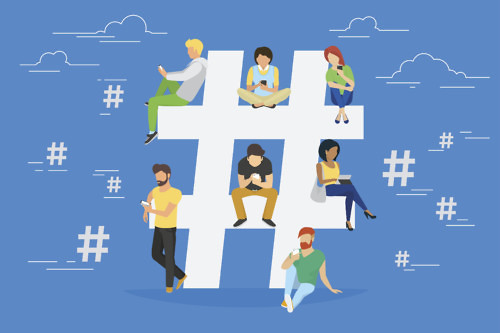Throughout history, the ‘#’ sign has been used to signify the word “pound” or “number.” Then, in 2007, a former Google employee named Chris Messina tweeted an idea that would change its meaning forever.
how do you feel about using # (pound) for groups. As in #barcamp [msg]?
— Chris Messina 🐀 (@chrismessina) August 23, 2007
A decade later, the pound sign has been rebranded to now be called a “hashtag”. Most millennials and younger generations only know it by that name. Almost 75% of social media users post with hashtags frequently. They have become so common that the term was added to the Oxford dictionary in 2010 and someone once even named her baby after it.
Hashtags allow the entire online community to join a conversation about events, holidays, hot topics, and many more. Companies use them to engage with consumers and promote their content. When it comes to using them for business purposes, the trick is knowing how to do it well.
What Are Hashtags Used For?
What are hashtags used for? There are 6 types of hashtags:
- Campaign Hashtags – Tags created for a specific marketing campaign. Brands encourage people to use them for further promotion. For example, when Apple launched the iPhone X, it wanted to show how much the camera had improved and prompted users to share their original photos using the hashtag #ShotOnIphoneX. It’s free publicity.
- Brand Hashtags – A tag of your brand name or slogan. This lets you track how many times your company is mentioned online. When you search the hashtag #ImLovinIt, you’ll see messages about McDonald’s.
- Trending Hashtags – Hashtags about a current popular topic. They are great for targeting a niche market. In 2013, Oreo joined the #FashionWeek trend by tweeting that Oreos wear all black “because all white was soooooo last week.”
- Content Hashtags – Commonplace tags. They are not branded, not part of a campaign, and not trending. They are simply regular words and phrases that apply to any topic, such as #Marketing #DirectMail #Printing #SocialMedia. These help boost your SEO.
- Event Hashtags – Tags that help spread the word about an upcoming or current event, like the #SuperBowl or #Oscars.
- Location Hashtags – Geographically targeted hashtags, great to use for locally-owned businesses. NextPage is located in #KansasCity or #KC.
Before you post with a hashtag, I recommend checking two things. First, see how popular the tag is right now. Are people even using it? Hashtagify.com is an excellent place to do so. If it’s popular, then you have a better chance of increasing views. Second, verify that the tag is relevant to your content. Examine other posts with the same hashtag and ensure you want yours to be included on that list. For example, I was in a workshop once and had an exercise to tweet about an event in Lawrence, Kansas. I posted with the hashtag #Lawrence but when I clicked on it, most of the content was about Jennifer Lawrence. The hashtag #LawrenceKS would have been more specific. Lesson learned.
Hashtags To Get Followers
You may think that the more hashtags to get followers the better, right? Not always. Here is a breakdown of how to best use hashtags as a promotional tool for each social media platform.
Hashtags To Get Followers On Instagram:
On Instagram, yes, numerous hashtags are good. They are the most effective way to gain likes, get followers, and build a community. Instagram allows 30 hashtags per post maximum, but you should use up to 11 for best results, as long as they’re all relevant to the post. Use a mix of hashtags to get followers on instagram using branded and content hashtags. For instance, if you post a photo from Jimmy John’s then you could tag #JimmyJohns #FreakyFast #Sandwiches #Dinner #Food.
How To Use Hashtags To get More Followers on Twitter:
Learn how to use hashtags to get more followers on Twitter. Unlike Instagram, Twitter recommends one or two hashtags per post. Statistics show that Twitter viewership actually decreases if you have more than that. Since tweets only allow 140 characters, typing too many hashtags leaves less room for content. Tweets with two hashtags maximum receive twice as much engagement as those without, and they’re 55 percent more likely to be retweeted. Twitter is the best place for using hashtags to categorize your material.
Facebook Hashtags:
Facebook wasn’t set up for hashtags until 2013 and it hasn’t been a big hit. Like Twitter, Facebook recommends only a couple hashtags per post. Too many of them will lead to fewer interactions. If your target audience is business-oriented, then using Facebook hashtags certainly can’t hurt, but they work better when combined with other media.
Modify your #Hashtag usage and watch your social media viewership rise.

